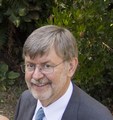United States Senator Patrick Leahy sponsored the 2015 Leahy Environmental Summit – held in Burlington, Vermont – to launch the "Climate Change Resilient, Floodwater Smart initiative"

“The Climate Change Resilient, Floodwater Smart initiative is based on a simple notion that when it comes to enterprise innovation and integration, there is nothing that brings out the best in human systems, faster, more consistently, and more effectively, than the power of ‘the whole’,” stated Senator Patrick Leahy. “True innovation happens when strong multi-disciplinary groups come together, build a collaborative interchange, and explore their different points of strength.”










